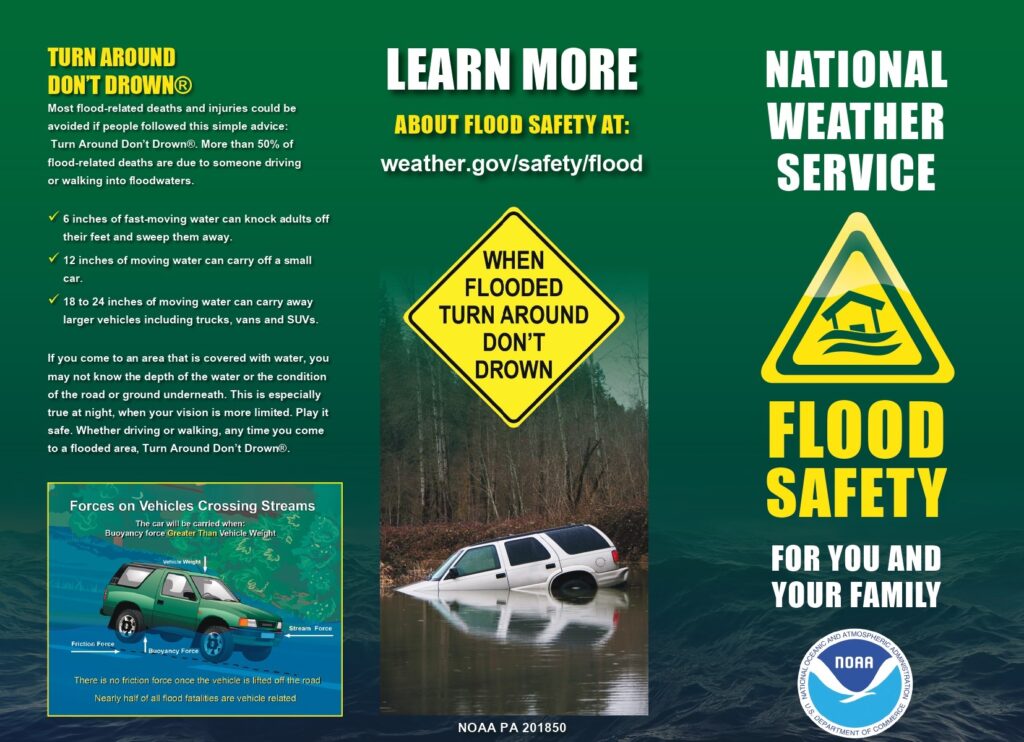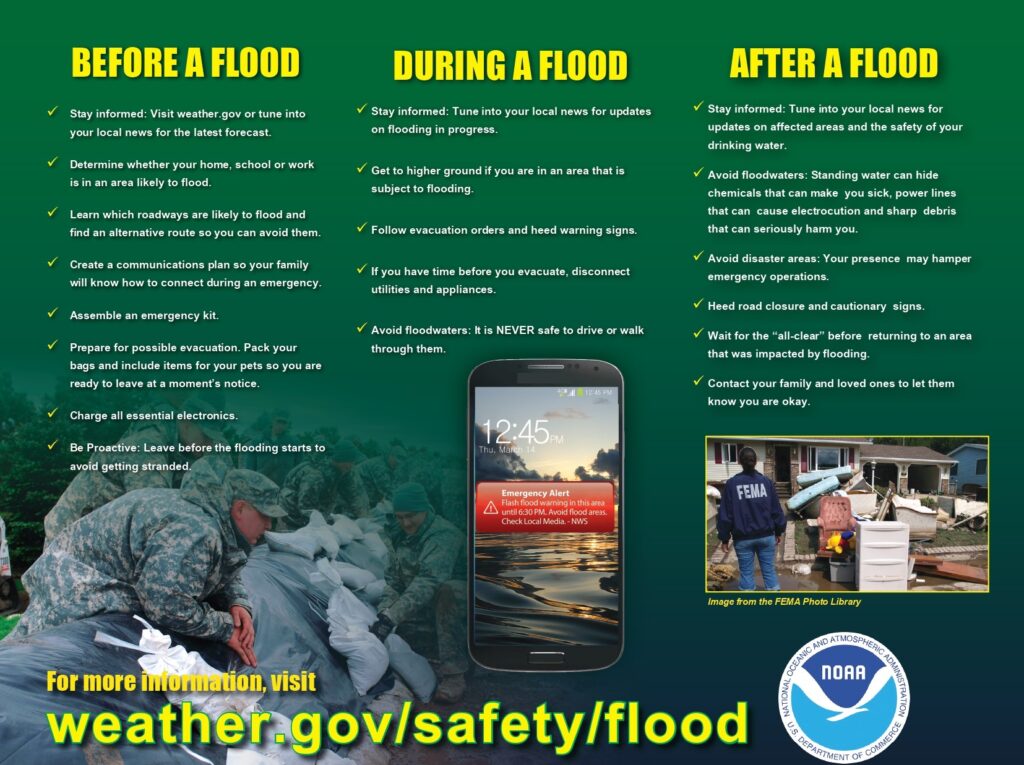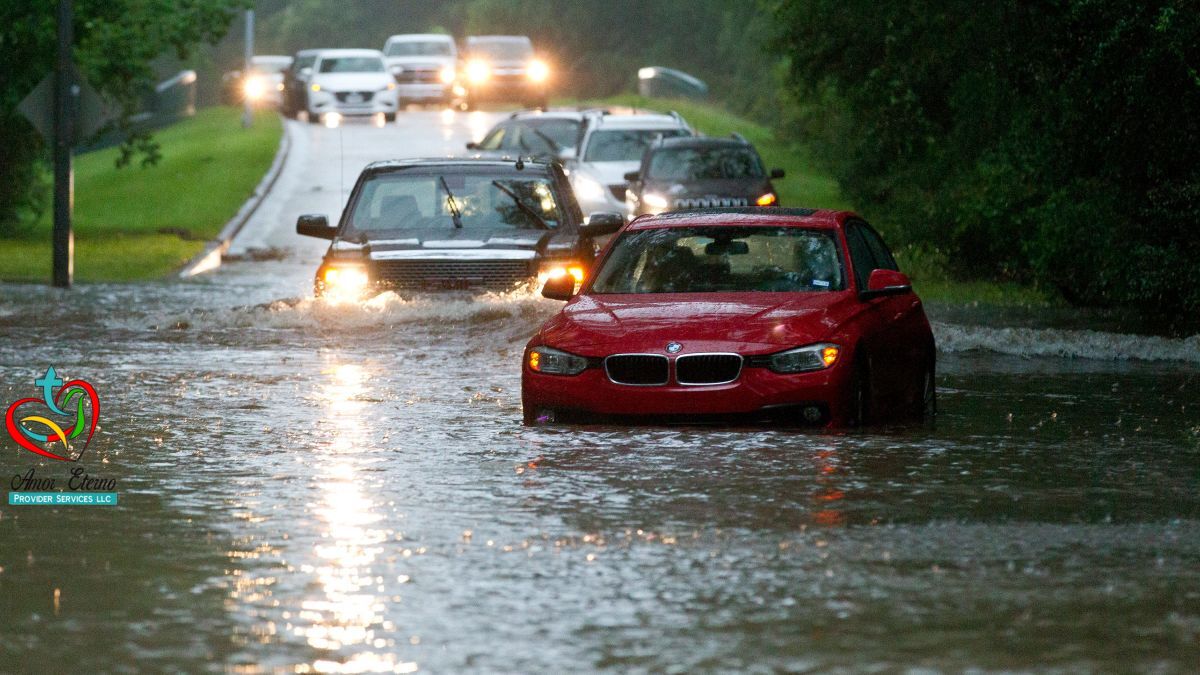Difference between Flash Flood Warning, Flood Warning, and Flood Watch
- Flash Flood Warning: Take Action! -When a flash flood is imminent or occurring. If you are in a flood prone area move immediately to high ground. A flash flood is a sudden violent flood that can take from minutes to hours to develop. It is even possible to experience a flash flood in areas not immediately receiving rain.
- Flood Warning: Take Action!- When the hazardous weather event is imminent or already happening. A Flood Warning is issued when flooding is imminent or occurring.
- Flood Watch: Be Prepared– When conditions are favorable for a specific hazardous weather event to occur. A Flood Watch is issued when conditions are favorable for flooding. It does not mean flooding will occur, but it is possible.
Before a Flood
- Communication Plan– It is important to be able to communicate with your family and friends in the event of a disaster. Whether it is having a specific person identified to contact for status updates or a safe location to meet up with family members, having a plan in place will give you peace of mind if disaster does strike.
- Emergency Kit-It is good practice to have enough food, water and medicine on hand at all times to last you at least 3 days in the case of an emergency. Water service may be interrupted or unsafe to drink and food requiring little cooking and no refrigeration may be needed if electric power is interrupted. You should also have batteries, blankets, flashlights, first aid kit, rubber boots, rubber gloves, and a NOAA Weather Radio or other battery operated radio easily available.
- Know the Risk-Is your home, business or school in a floodplain? Where is water likely to collect on the roadways you most often travel? What is the fastest way to get to higher ground? Knowing the answers to these questions ahead of time can save your life.
- Sign up for Notifications-The Advanced Hydrologic Prediction Service provides RSS feeds for observed forecast and alert river conditions to help keep the public informed about local water conditions
- Prepare your home– Sometimes floods develop slowly and forecasters can anticipate where a flood will happen days or weeks before it occurs. Oftentimes flash floods can occur within minutes and sometimes without any sign of rain. Being prepared can save your life and give you peace of mind.
- 1. If you have access to sandbags or other materials, use them to protect your home from flood waters if you have sufficient time to do so. Filling sandbags can take more time than you may think.
- 2. Have a professional install check-valves in plumbing to prevent flood waters from backing up into the drains of your home. Make sure your sump pump is working and consider having a backup. Make sure your electric circuit breakers, or fuses, are clearly marked for each area of your home.
- 3. Since standard homeowners insurance doesn’t cover flooding, ensure coverage by contacting your insurance company or agent to purchase flood insurance. This must be done before there is even a threat of flooding as insurance companies stop issuing policies if there is a threat of flooding. (i.e. an approaching hurricane). Many flood insurance policies take at least 30 days to go into effect so even if you can buy it as a storm is approaching, it may not protect your investment.
- Prepare your family/friends– You may be evacuated, so pack in advance. Don’t wait until the last moment to gather the essentials for yourself, your family and/or your pets.
- Charge Essential Electronics– Make sure your cell phone and portable radios are all charged in case you lose power or need to evacuate. Also make sure you have back-up batteries on hand.
- Leave– If it is likely your home will flood, don’t wait to be ordered to leave; evacuate yourself! Make alternative plans for a place to stay. If you have pets, take them with you or make arrangements to board them at a facility well away from the flooding danger.
During a Flood
During a flood, water levels and the rate the water is flowing can quickly change. Remain aware and monitor local radio and television outlets. Avoid flood waters at all costs and evacuate immediately when water starts to rise. Don’t wait until it’s too late!
- Stay Informed– Listen to radio and television, including NOAA Weather Radio if possible, check the Internet and social media for information and updates.
- Get to Higher Ground- If you live in a flood prone area or are camping in a low lying area, get to higher ground immediately.
- Obey Evacuation Orders– If told to evacuate, do so immediately. Lock your home when you leave. If you have time, disconnect utilities and appliances.
- Practice Electrical Safety– Don’t go into a basement, or any room, if water covers the electrical outlets or if cords are submerged. If you see sparks or hear buzzing, crackling, snapping or popping noises–get out! Stay out of water that may have electricity in it!
- Avoid Flood Waters– Don’t walk through flood waters. It only takes 6 inches of moving water to knock you off your feet. If you are trapped by moving water, move to the highest possible point and call 911 if possible. Do NOT drive into flooded roadways or around a barricade; Turn Around, Don’t Drown! Water may be deeper than it appears and can hide hazards such as sharp objects, washed out road surfaces, electrical wires, chemicals, etc. A vehicle caught in swiftly moving water can be swept away in seconds 12 inches of water can float a car or small SUV, 18 inches of water can carry away large vehicles.
After a Flood
When flood waters recede, the damage left behind can be devastating and present many dangers. Images of flood destruction depict destroyed homes and buildings, damaged possessions, and decimated roadways. However, what you can’t see can be just as dangerous. Floodwaters often become contaminated with sewage or chemicals. Gas leaks and live power lines can be deadly, but are not obvious at first glance.
All Age Groups
No matter what your age, everyone can benefit from a healthy diet and adequate physical activity.
- Choose a healthy eating plan. The food you eat can decrease your risk of heart disease and stroke.
- Choose foods low in saturated fat, trans fat, and sodium. As part of a healthy diet, eat plenty of fruits and vegetables, fiber-rich whole grains, fish (preferably oily fish-at least twice per week), nuts, legumes and seeds and try eating some meals without meat. Select lower fat dairy products and poultry (skinless). Limit sugar-sweetened beverages and red meat. If you choose to eat meat, select the leanest cuts available.
- Be physically active. You can slowly work up to at least 2½ hours (150 minutes) of moderate-intensity aerobic physical activity (e.g., brisk walking) every week or 1 hour and 15 minutes (75 minutes) of vigorous intensity aerobic physical activity (e.g., jogging, running) or a combination of both qevery week. Learn the American Heart Association’s Guidelines for Physical Activity in Adults and in Children. Additionally, on 2 or more days a week you need muscle-strengthening activities that work all major muscle groups (legs, hips, back, abdomen, chest shoulders, and arms). Children should get at least 60 minutes of activity every day.
- It’s never too early or too late to learn the warning signs of a heart attack and stroke. Not everyone experiences sudden numbness with a stroke or severe chest pain with a heart attack. And heart attack symptoms in women can be different than men.



